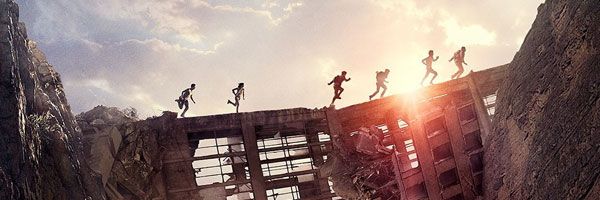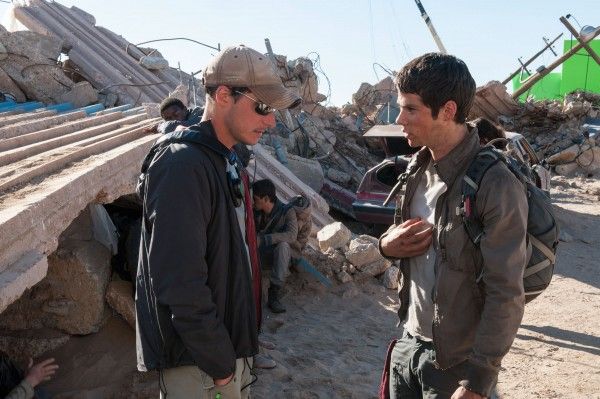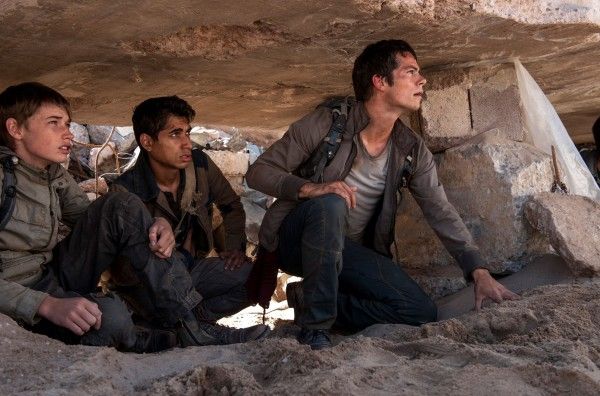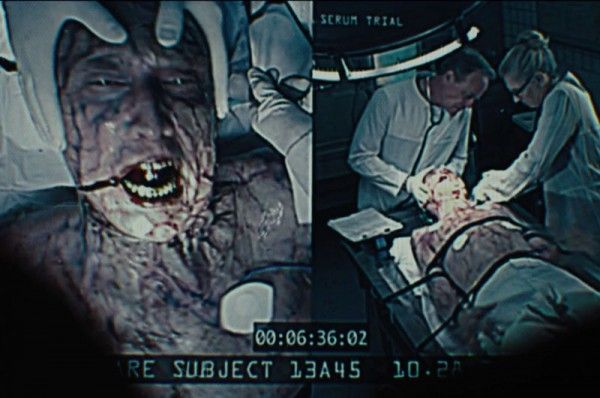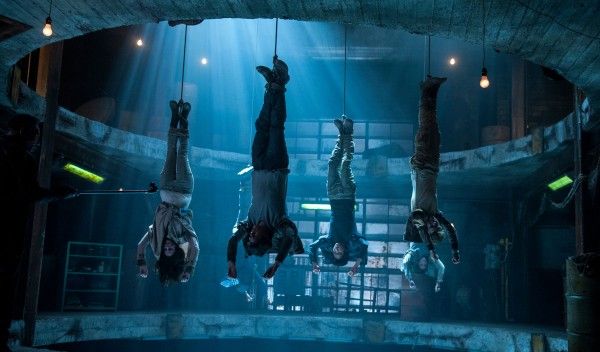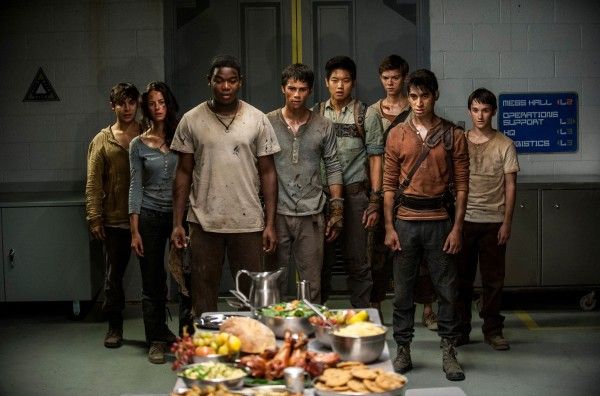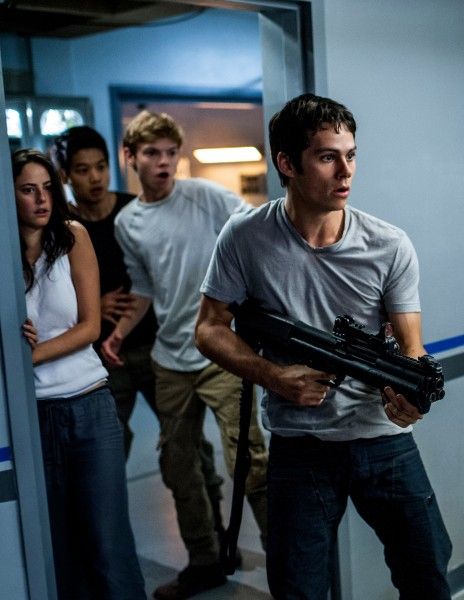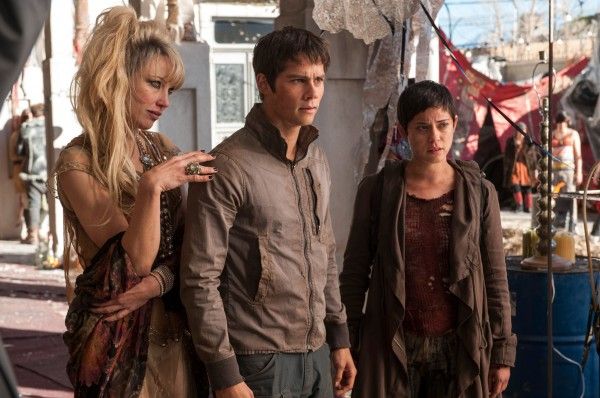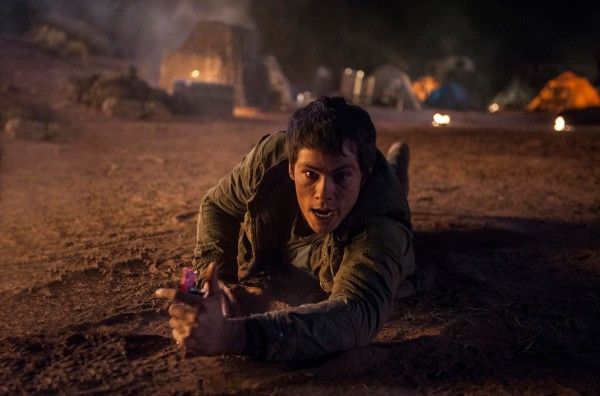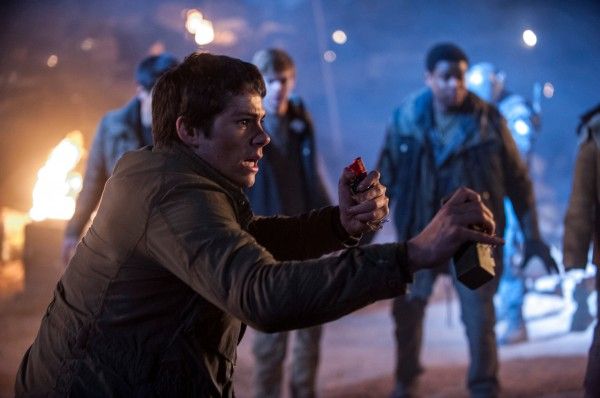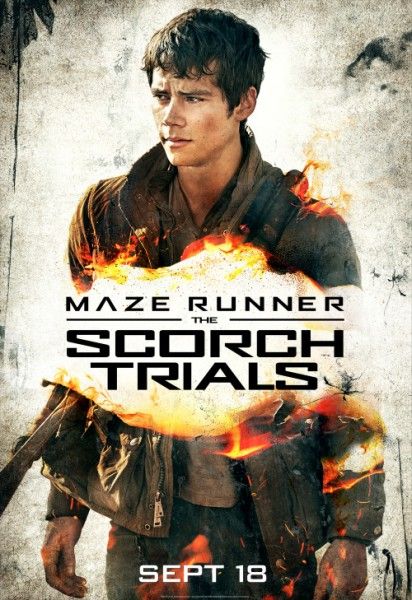You’d think a $32 million opening and primarily positive reviews would put producer Wyck Godfrey at ease, but the success of the first Maze Runner movie only upped the pressure for him to deliver big with the second, Maze Runner: The Scorch Trials. This time around, the story isn’t confined to the Glade and the Maze. The Gladers are out, but in order to find out what WCKD is really up to, they’ve got to make their way through yet another treacherous terrain, the Scorch.
While visiting the Albuquerque, New Mexico set of The Scorch Trials during production, I got the opportunity to participate in a roundtable interview with Godfrey during which he revealed loads of details regarding the shooting schedule and the changes made to the source material during the adaptation process. Find out which characters from The Death Cure are being introduced early, what changes they made to the party scene, why Maze Runner is a young adult standout, and loads more in this on-set interview.
And in case you missed it, you can also check out the latest Maze Runner: The Scorch Trials trailer below. The film is due in theaters on September 18th and stars Dylan O’Brien, Thomas Brodie-Sangster, Kaya Scodelario, Giancarlo Esposito, Ki Hong Lee, Rosa Salazar and Jacob Lofland.
Question: What day are we on?
WYCK GODFREY: We are, I think, day 36 out of 55. So yeah, we’re getting through it. I’m gonna find out exactly [checks shooting schedule]. Yes, day 35 of 55. So yeah, it’s good. It’s going really well. We’re trying to maintain the feeling that it’s The Scorch Trials in winter in Albuquerque. The magic of movie making.
What can you tell us about the location?
GODFREY: So this location, if any of you know the book, if not, basically, Thomas and the Gladers have to journey across this expansive desert scorch and right as they’re about to get in the middle of this storm, they kind of come to this sort of destroyed city and they meet Jorge and Brenda, and Jorge and Brenda sort of have this, you know, our version of the merry band of pirates that are struggling to survive in the world of the Flare. And WCKD finds them and attacks their base and ultimately, Thomas and Brenda get separated from everybody else, and they’re making their way through the city and they kind of get waylaid by these weird people forced into this very bizarre party scene. And so where we are today is this abandoned mansion in Albuquerque that is serving as this party. I like to think of it as our kind of Pinocchio scene, where Pinocchio goes into the pool house and starts to grow ears and a tail and almost never wants to leave, and I think that’s kind of thematically what happens here. Thomas, who is always concerned for his friends and feels a sense of responsibility for sort of what he’s gotten them in, comes into this place and they’re forced to drink this liquid, they start to all trip out and people start to look weird and Brenda’s point of view as a survivor is, ‘There’s no reason to worry about anybody but yourself, this is the life, it’s a disaster, let’s just stay and not go.’ And so you have this kind of cool scene and ultimately his friends end up at the last minute finding him and pulling him out. So that’s what we’re shooting today.
With Wes [Ball] being so lovable and so great with what he did with the first movie, did you give him more money on this one and more room to play?
GODFREY: Yeah, I mean, it’s a bigger movie for sure than the first one, just by nature. The first movie was very much a contained - we had two locations, you know, we had the Glade and we had the Maze. Here the story is a journey through the world. It’s really about discovering the outside world. Everything they wanted to know in the first movie, they start to discover in this movie and it gets much bigger so, by its very nature, there are many more locations, there’s a bigger cast and so he has more days to shoot which generally means more money, and ultimately the success of the first movie allowed us to kind of give him a little bit more to play with.
How many of the locations did you keep from the book? There’s a lot of really big set pieces in that one.
GODFREY: I think we kept almost everything and added. It’s ultimately gonna be a bigger movie than the second book because that’s just the way Wes dreams. He’s like, ‘If I wanna show the real world, I wanna show it,’ and so his version of traveling the Scorch is a much broader, bigger vision than we probably in our minds imagined what crossing the Scorch would be like, in the same way that his vision of the walls in the Glade were bigger probably than what most of us thought of when we read the book.
How many changes are there from the book? Does it split at any point or is it really close to it?
GODFREY: No, I mean, it’s very close to the spirit. The same general arc of the second book is the arc of the movie. There are things where we’ve kind of been reading the book and we go like, ‘Wait, I’m a little confused here,’ and, ‘Does that make sense?’ And in particular, you want to make sure that your characters are driving the story, that they’re the ones making choices and that they’re not reacting to everything WCKD does. So the changes we made tried to allow them to be sort of more proactive, but they still very much, you know, in the first act the people that saved them are not who we thought they were, they end up having to get out of there and cross the Scorch, they come and meet Brenda and Jorge, and they push forward, there are betrayals. So it’s very much to the spirit of the second book and James has been involved the whole way and the things that we’ve changed he’s been like, ‘Shit, I wish I would have thought of that for the book.’ He’s great that way. He’s kind of like John Green where he’s like, ‘You know what? That’s better. Let’s do it that way,’ so it’s all good. [Laughs]
Like you said, the first movie and the first book were very contained. What’s it been like watching the new cast integrate with the old cast?
GODFREY: I think that’s been probably the most fun for all of us is adding people to the mix that weren’t part of the first movie, in particular some of our adult actors. We took a very different approach to Hunger Games and Divergent in that the thing I love about Wes is that he wants everything to feel grounded and real. Anything in the books that felt in his mind too farfetched that he didn’t believe as a viewer, he wouldn’t do. And the same thing sort of came to the actors that we got for Jorge and Brenda. He just wanted people that felt like what he envisioned in the book. We cast people like Giancarlo Esposito, who’s shooting today, we cast Alan Tudyk who plays Blondie, we’ve cast Barry Pepper who actually is a character from the third book that was sort of brought up early, Vince, and Mary also from the third book that we brought up, Lili Taylor. So we’ve got these actors that are just quality, great actors but aren’t kind of movie stars, you know? Because I think sometimes when I watch those other movies I feel like I’m seeing somebody that I’ve seen in all these other movies, it kind of pulls me out of the fantasy a little bit. So yeah, it’s been great and of course Dylan and Dexter and Ki Hong and Kaya all love the new people because it’s just like, ‘Finally some new blood!’
How about the creature design this time around?
GODFREY: Whereas in the first film the Grievers were the big thing, in this one the Cranks are, and again, Wes’ vision of what this disease does to you and how it takes over is sort of more visual and more exciting than what we might have expected reading the book. We have several stages of the Flare overtaking you and there are of course early versions of the Cranks where you see more of the humanity and then there are later versions of the Cranks where they’re gonna be fully CG and they’re truly terrifying. So that would be kind of our monsters of this movie.
Wes really came into the first one talking about doing most thing practical. Is he sticking with that?
GODFREY: Yeah, I mean, I think everything in the same way is as real as the first film was, except for the Grievers, this movie is too. A lot of stunts, a lot of real action. Our stunt coordinator George [Cottle] said yesterday, ‘The truth is, if Dylan decided he didn’t want to act anymore, he could be a stuntman tomorrow.’ He’s so good. His physicality is so great and he’s willing to do everything and he’s got a sprained wrist right now but he’s still going through with everything and that of course infuses energy into every scene because all of the other actors see that and they want to do as well as him and so they go on their training regime and it’s been great. So all of the action is very, very sort of real and there’s not a lot of kind of fully CG shots where you see digi-doubles flipping around.
Is the majority of the movie shooting in and around Albuquerque?
GODFREY: Almost everything is around here. Fortunately there’s sand dunes that are within an hour of here that we could shoot a lot of the Scorch in, we’ve got mountains right here that they’re trying to journey to. They’re sort of our version of the safe haven.
With the first movie being an introduction to this world that James created, what would you say that The Scorch Trials does in terms of moving the story along and conveying what the overall trilogy is about?
GODFREY: I kind of like to say that it’s thematically what you go through in adolescence, you know? You spend your childhood wanting to get out from your house and wanting to get away and out into the real world and then as adults we start to learn that things are not what we thought they were. They can be very difficult and I think that sort of dream of the outside world sometimes when it’s revealed can be imposing and dangerous, and I think that’s sort of thematically what happens to the Gladers. They’ve wanted to break free from their environment for the entire first movie and in the second movie they do and Thomas’ kind of core journey is feeling responsibility for having told everyone, ‘We have to get out of this place,’ and now that he has, bad things happen and you lose friends and you feel a sense of responsibility and you have kind of people voice in the movie like, ‘Maybe we should have never left the Glade,’ and I think that’s incredibly powerful and relatable, too. I think it’s one of the reasons why the books series and the movie were so popular is because despite it being a science fiction film, it’s about something you feel inside. You feel like, ‘Adults are controlling me and containing me and I want to break free from that,’ but in breaking free from that you yourself become an adult and you see how difficult it is.
Is that why you think the dystopian future is so popular right now, because it speaks to a journey that people are taking?
GODFREY: I think in science fiction there are always trends, you know? There comes dystopian and then it becomes science fiction about rebirth, and I think right now there’s that sense of, ‘Adults have messed up our world and it’s gonna be left to us to figure out how to rebuild it,’ and so whether you call it dystopian or sort of rebirth fiction, that’s what’s going on and that’s very much the journey that these Gladers go on, is ultimately throughout the course of the book series you’re gonna realize, ‘Maybe there are no cures for the diseases that we’ve been left with and we need to just rebuild and restart and be allowed to make our own choices’
How do you feel about those comparisons to Divergent and Hunger Games? How difficult has it been to assert that this is completely different?
GODFREY: Well, I mean, I think any anxiety we had was probably going into the first movie, and now those anxieties have gone away. I think the bet we made was that a science fiction series with male protagonists would separate it and would sort of help even out the audience sort of male and female. And Dylan really did a great job at bringing Thomas to life in a way that made the movie feel fresh for audiences and didn’t feel, you know, derivative of Hunger Games and Divergent. I think also what you talked about that [Wes] shot it in a way and created a world that felt so grounded and real and you didn’t have the Capitol with all of its broad, colorful splendor made the texture of the movie feel real and grounded, so I think that’s helped a lot.
Were there any reactions to the first movie that you took to heart and incorporated here?
GODFREY: The truth is, by the time the movie came out we were deep into prep and we were making the movie. And I think hats off to Fox for allowing us to do that and recognizing that we have to bet on the success of the first movie and be willing to sort of put it in motion so that if the movie works, we can have the second movie a year later because, as we all know with young audiences and fans of these series, they want them as fast as they can get them. We’re also dealing with Dylan’s schedule in Teen Wolf and knowing that he had to go back in the beginning of the year, so we really had a window to make the movie. I think that if anything it was just that the movie worked and it validated the choices we made there. Obviously things like dropping the telepathy was something that we angsted about when we were making the first film but it was something that Wes and talking to James we felt really strongly that that’s not a very interesting visual thing. Every movie that I’ve seen it in, that Wes had seen it in, it always comes across a little cheesy so it’s like, ‘Can we make this story without telepathy, James?’ And we talked about it and James was on board with it and it wasn’t like there were people with pickets outside going, ‘You lost the telepathy!’ There are always gonna be those things that no matter what you cut and change, people are gonna be upset because it was their favorite thing in the book. What you hope for is that the overall experience of the movie is more than fulfilling their expectations, and if you do that you’ve succeeded even if you made changes from the book. And if you don’t, then you deserve to get raked over the coals.
You mentioned the tight turnaround. Does that force any concessions, rush the adaptation or anything like that?
GODFREY: No, we started writing the script, the second script, last January, so that was the first step to getting the studio to believe in the movie enough to let us spend the money to start on a script. By the time May rolled around, we had a really good script and that was where we said, ‘Can we start scouting? Can we start putting this movie together?’ And ultimately I think if you ask Wes he’s gonna say, ‘Yeah, I feel the strain of having finished the first movie while I was prepping the second movie and doing press for the first movie.’ It’s probably been the most difficult strain on him, but we try to surround him with enough support that he can get through it and I think we’ll probably have a little more time, even with Dylan’s schedule on Teen Wolf, to get the third and have a little more time. We don’t have to have the same start date next year.
When you guys were prepping the second movie and then the first film came out, did you go, ‘Okay, now we can just move on. We don’t have to worry about this?’
GODFREY: Oddly enough it was the opposite. It was like, ‘Oh shit, now we really gotta make the second one good!’ [Laughs] I mean, it’s not like all of a sudden it was like, ‘Great, it worked. Here’s another check for $20 million and add to your budget and do whatever you want.’ It was like, we had a plan and we had a script and we had a cast and we knew what we were doing. The only anxiety was like, ‘Oh my gosh, we’re really making it.’ There was always that fear of like, September 21st the studio could have called up and said, ‘Well, thanks for all the hard work. The movie didn’t work. We’re shutting down production.” So up until that Friday and kind of the numbers coming in and everyone going, ‘You’re making the movie in five weeks.’ And you’re like, ‘Okay, 24/7. Get working.’ [Laughs]
Were there any other things in the second book, like the telepathy in the first book, that you had to adapt?
GODFREY: Yes, but honestly I don’t want to talk about them yet because I think they’re gonna be surprises that, like anything, you kind of want to be pleasantly surprised and you want to kind of figure out sort of how to send that messaging out. So there are gonna be changes similar to that, but I think when explained everyone’s gonna be like, ‘Oh, I get that. That’s why. That’s better.’ Otherwise we wouldn’t have done it.
You mentioned that you were shooting this five weeks after the opening of the first film. Is that accurate?
GODFREY: I think it was. I wanna say it was like five weeks. Yeah, September 19th and we were shooting October 27th. But, that’s not to say we started prep. We were here, we were all working as if, you know, we were 15 weeks into prepping it. It was just that there’s that extra gear that you go into when it’s all of a sudden upon you.
In The Death Cure there are some things we find out about certain characters. Are any of those hints going to come early in The Scorch Trials?
GODFREY: No, I mean, nothing that unless you’re like a real - you always try to have those little Easter eggs in the movie that I think you’ll pick up on, or that you project as an audience member onto something, but if you do there’s usually a chance that Wes has thought of like, ‘I wanna set that up for the next movie.’
Have you given much thought to keeping the films consistent? I’m just thinking about what they did with Hunger Games where it’s like the first two films were in the Games and then all of a sudden that was gone. Is there any concern about viewers leaving the Maze, feeling lost and needing to readjust?
GODFREY: Well, it’s interesting. I think when I read the books I kind of go, ‘What was WCKD really doing with the Grievers? What did that have to do with anything?’ And the truth is, you can talk to James sometimes and he’s like, ‘Guys, I’m a writer. I spent 10 years on the first book and then I had a due date for the second and the third one.’ A lot of people don’t understand that with Veronica [Roth] and Divergent, apart from J.K. Rowling and Stephanie Meyer, I think most of the writers are having to kind of scramble and continue to invent and make things up, and that’s why a lot of times they’re all like, ‘Guys, it’s not sacrilege to say you can improve upon the book because I myself, had I taken 10 years to write each of the subsequent books, probably would have been able to write them better.’ And I think there are things where you kind of go like, and same thing with Hunger Games, you go like, ‘I’m not quite sure I understand what the Grievers were for,’ and then in the movies you try to kind of connect tissue that wasn’t in the second book. And so I think what you’re saying is true and I think we do try to make little connections and keep threads alive. We’re actually shooting a scene right this minute, I think, that’s not in the book - spoiler alert.
That’s good because this scene is so brief in the book. I’m excited that you’re expanding it a little.
GODFREY: Yeah, well, it’s a little thing but Wes had said, ‘When Thomas starts to trip out and starts to spin out and starts to see things, I want him to like turn and see like a Griever rearing out of the shadows because I feel like we just dropped it and we’re just on to a totally new thing.’ Is that in the book? No. Is it cool and is it gonna be additive to what the fans liked from the first book? Yes.
Clearly there’s a built-in fan base, but is there anything you’re doing to make it friendly to people who might be tuning in just for the second movie?
GODFREY: Look, my hope is that everybody between the theatrical experience, the online, the digital experience, the DVD experience, and paid television, by the time this second film comes out that people coming to Scorch Trials will have seen the first movie in some capacity by then. If they don’t and if they haven’t, they’re gonna go to the movie, be entertained and have to ask questions like, ‘Wait, I’m a little confused who that was,’ but look, you want the movie experience to be fulfilling no matter if you’re sitting on a plane and it happens to be on or not.
SPOILER ALERT! Warning: The last part of this Q&A contains major plot spoilers.
Is there something to take the place of the telepathy here? We didn’t really get much of the romance between Thomas and Teresa in the first movie and in this book, the telepathy is even more important when it comes to that.
GODFREY: Yeah, I mean, I think what we’ve done is try to as - you know, there’s a section of the books I don’t want to get too much into, where certainly part of the choice is, will you get your memory back or not? I think that we did it sort of through dream sequences in the first film that you felt that there was a connection between Thomas and Teresa. We’ve expanded on that a little bit. I think Teresa has secrets in the second movie. Thomas and Aris have secrets, so there is that sense of you know something’s going on but you don’t know, but we’re not having to be like, ‘I’m talking to you in your head and you can hear what I’m saying. I’m not gonna tell them what I’m saying’
I had read something about a character that’s gonna be killed off that isn’t in the book. Is that true?
GODFREY: No, no.
Oh, ok. Misdirection out there online.
GODFREY: No, no. I mean, who here knows who dies in the first half of Scorch Trials, right? So who is that? It’s Winston and Jack. Jack we will discover was in the first movie. You’ll recognize him but we never named him, he didn’t have a name. So, again, we’re trying to kind of keep in line with the general journey that the characters go on.
How are you gonna handle what happens to Winston, and the gore in general?
GODFREY: Yeah, look, we’re gonna be PG-13. We’d be betraying our audience if it was R and so there are certainly things in terms of the level of gore that you have to shy away from. I will say that the experience of Winston’s death in the movie is far more emotional, I think, than it probably was in the book. It’s one thing about when you bring something to visual life, you invest emotions in characters visually that you don’t even realize you fully had and then you see the scene where they’re dealing with him dying and you’re like, ‘Oh my gosh, they loved him. They cared about him.’ So I think it’ll be exciting.
That’s great because it’s definitely like, sad … moving on.
GODFREY: Yeah. And again, it’s a testament to Dylan as an actor. He carries the weight of that moving forward in scenes that follow. It’s not just like, ‘Yeah, yeah, we gotta get over there.’ It’s like, he feels like he cost Winston his life.
Check out the rest of my Maze Runner set visit coverage using the links below:
- ‘Maze Runner: The Scorch Trials’: Dylan O’Brien Talks Stunts, Unromantic Romance and More
- ‘Maze Runner: The Scorch Trials': Wes Ball on New Locations, Book Changes and More
- ‘Maze Runner: The Scorch Trials’ Set Visit Interview: Surprise! Alan Tudyk is Blondie

